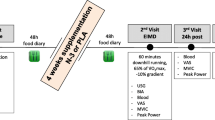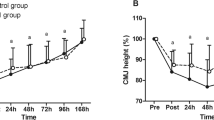Abstract
The aim of the current study was to examine the effects of cold water immersion (CWI) with and without the free acid form of β-hydroxy-β-methylbutyrate (HMB-FA) on markers of muscle damage following acute lower body resistance exercise. Forty recreationally resistance-trained men (22.3 ± 2.4 years) were randomly divided into one of the four groups: (1) Placebo (PL); (2) HMB-FA; (3) HMB-FA-CWI; (4) PL-CWI. HMB-FA groups ingested 3 g day−1 and CWI groups submersed their lower body into 10–12 °C water for 10-min post-exercise. No differences between groups were observed for CK; however, PL-CWI had significantly greater elevations in myoglobin 30-min post-exercise compared to HMB-FA (p = 0.009) and PL (p = 0.005), and HMB-FA-CWI was significantly greater than HMB-FA (p = 0.046) and PL (p = 0.028). No differences between groups were observed for IL-6 and IL-10, although CRP was significantly greater 24-h post-exercise for PL-CWI compared to HMB-FA-CWI (p = 0.02) and HMB-FA (p = 0.046). Only HMB-FA-CWI showed significantly (p = 0.02) greater improvements in average power per repetition. CWI appeared to elevate myoglobin compared to other groups, while HMB-FA may have attenuated the increase in CRP when combined with CWI. Nevertheless, HMB-FA or CWI treatments did not appear to provide benefit over PL for recovery. Instead, the combination of CWI and HMB-FA improved performance recovery compared to other groups.






Similar content being viewed by others
References
Banfi G, Lombardi G, Colombini A, Melegati G (2010) Whole-body cryotherapy in athletes. Sports Med 40(6):509–517
Black S, Kushner I, Samols D (2004) C-reactive protein. J Biol Chem 279(47):48487–48490
Brzycki M (1993) Strength testing—predicting a one-rep max from reps-to-fatigue. J Phys Educ Recreat Dance 64(1):88–90
Buford TW, Cooke MB, Willoughby DS (2009) Resistance exercise-induced changes of inflammatory gene expression within human skeletal muscle. Eur J Appl Physiol 107(4):463–471
Calle MC, Fernandez ML (2010) Effects of resistance training on the inflammatory response. Nutr Res Pract 4(4):259–269
Croisier JL, Camus G, Venneman I, Deby-Dupont G, Juchmès-Ferir A, Lamy M, Crielaard JM, Deby C, Duchateau J (1999) Effects of training on exercise-induced muscle damage and interleukin 6 production. Muscle Nerve 22(2):208–212
Dill D, Costill DL (1974) Calculation of percentage changes in volumes of blood, plasma, and red cells in dehydration. J Appl Physiol 37:247
Eley HL, Russell ST, Baxter JH, Mukerji P, Tisdale MJ (2007) Signaling pathways initiated by β-hydroxy-β-methylbutyrate to attenuate the depression of protein synthesis in skeletal muscle in response to cachectic stimuli. Am J Physiol Endocrinol Metab 293(4):E923–E931
Eston R, Peters D (1999) Effects of cold water immersion on the symptoms of exercise-induced muscle damage. J Sports Sci 17(3):231–238
Fuller JC, Sharp RL, Angus HF, Baier SM, Rathmacher JA (2011) Free acid gel form of β-hydroxy-β-methylbutyrate (HMB) improves HMB clearance from plasma in human subjects compared with the calcium HMB salt. Br J Nutr 105(03):367–372
Hirose L, Nosaka K, Newton M, Laveder A, Kano M, Peake J, Suzuki K (2004) Changes in inflammatory mediators following eccentric exercise of the elbow flexors. Exerc Immunol Rev 10(75–90):20
Hoffman J (2006) Norms for fitness, performance, and health. Human Kinetics Publishers, Champaign, IL
Hoffman JR, Cooper J, Wendell M, Im J, Kang J (2004) Effects of [beta]-hydroxy [beta]-methylbutyrate on power performance and indices of muscle damage and stress during high-intensity training. J Strength Cond Res 18(4):747–752
Hoffman JR, Ratamess NA, Tranchina CP, Rashti SL, Kang J, Faigenbaum AD (2010) Effect of a proprietary protein supplement on recovery indices following resistance exercise in strength/power athletes. Amino Acids 38(3):771–778
Ingram J, Dawson B, Goodman C, Wallman K, Beilby J (2009) Effect of water immersion methods on post-exercise recovery from simulated team sport exercise. J Sci Med Sport 12(3):417–421
Kenttä G, Hassmen P, Kellmann M (2002) Underrecovery and overtraining: a conceptual model. Enhancing recovery: preventing underperformance in athletes. Human Kinetics Publishers, Champaign, IL
Kones R (2009) The Jupiter study, CRP screening, and aggressive statin therapy-implications for the primary prevention of cardiovascular disease. Ther Adv Cardiovasc Dis 3(4):309–315
Lee KA, Hicks G, Nino-Murcia G (1991) Validity and reliability of a scale to assess fatigue. Psychiatry Res 36(3):291–298
Leeder J, Gissane C, van Someren K, Gregson W, Howatson G (2012) Cold water immersion and recovery from strenuous exercise: a meta-analysis. Br J Sports Med 46(4):233–240
MacIntyre DL, Sorichter S, Mair J, Berg A, McKenzie DC (2001) Markers of inflammation and myofibrillar proteins following eccentric exercise in humans. Eur J Appl Physiol 84(3):180–186
Meyer T, Gabriel HH, Ratz M, Muller H, Kindermann W (2001) Anaerobic exercise induces moderate acute phase response. Med Sci Sports Exerc 33(4):549–555
Nissen S, Van Koevering M, Webb D (1990) Analysis of β-hydroxy-β-methyl butyrate in plasma by gas chromatography and mass spectrometry. Anal Biochem 188(1):17–19
Peake J, Nosaka KK, Muthalib M, Suzuki K (2006) Systemic inflammatory responses to maximal versus submaximal lengthening contractions of the elbow flexors. Exerc Immunol Rev 12:72–85
Pedersen BK, Steensberg A, Fischer C, Keller C, Ostrowski K, Schjerling P (2001) Exercise and cytokines with particular focus on muscle-derived IL-6. Exerc Immunol Rev 7:18
Petersen AMW, Pedersen BK (2005) The anti-inflammatory effect of exercise. J Appl Physiol 98(4):1154–1162
Phillips MD, Mitchell JB, Currie-Elolf LM, Yellott RC, Hubing KA (2010) Influence of commonly employed resistance exercise protocols on circulating IL-6 and indices of insulin sensitivity. J Strength Cond Res 24(4):1091
Pue CA, Mortensen RF, Marsh CB, Pope HA, Wewers MD (1996) Acute phase levels of C-reactive protein enhance IL-1 beta and IL-1ra production by human blood monocytes but inhibit IL-1 beta and IL-1ra production by alveolar macrophages. J Immunol 156(4):1594–1600
Ransone J, Neighbors K, Lefavi R, Chromiak J (2003) The effect of beta-hydroxy beta-methylbutyrate on muscular strength and body composition in collegiate football players. J Strength Cond Res/Natl Strength Cond Assoc 17(1):34–39
Ratamess NA, Kraemer WJ, Volek JS, Rubin MR, Gomez AL, French DN, Sharman MJ, McGuigan MM, Scheett T, HÄKKINEN K (2003) The effects of amino acid supplementation on muscular performance during resistance training overreaching. J Strength Cond Res 17(2):250–258
Smith L, Anwar A, Fragen M, Rananto C, Johnson R, Holbert D (2000) Cytokines and cell adhesion molecules associated with high-intensity eccentric exercise. Eur J Appl Physiol 82(1–2):61–67
Smith HJ, Mukerji P, Tisdale MJ (2005) Attenuation of proteasome-induced proteolysis in skeletal muscle by β-hydroxy-β-methylbutyrate in cancer-induced muscle loss. Cancer Res 65(1):277–283
Swenson C, Swärd L, Karlsson J (1996) Cryotherapy in sports medicine. Scand J Med Sci Sports 6(4):193–200
Tseng C, Lee J, Tsai Y, Lee S, Kao C, Liu T, Lai C, Harris M, Kuo C (2012) Topical cooling (icing) delays recovery from eccentric exercise-induced muscle damage. J Strength Cond Res 27(5):1354–1361
Uchida MC, Nosaka K, Ugrinowitsch C, Yamashita A, Martins E Jr, Moriscot AS, Aoki MS (2009) Effect of bench press exercise intensity on muscle soreness and inflammatory mediators. J Sports Sci 27(5):499–507
Van Someren KA, Edwards AJ, Howatson G (2005) Supplementation with [beta]-hydroxy-[beta]-methylbutyrate (HMB) and [alpha]-ketoisocaproic acid (KIC) reduces signs and symptoms of exercise-induced muscle damage in man. Int J Sport Nutr Exerc Metab 15(4):413–424
Versey NG, Halson SL, Dawson BT (2013) Water immersion recovery for athletes: effect on exercise performance and practical recommendations. Sports Med 43(11):1101–1130
Wilkinson DJ, Hossain T, Hill DS, Phillips BE, Crossland H, Williams J, Loughna P, Churchward‐Venne TA, Breen L, Phillips SM (2013) Effects of leucine and its metabolite β‐hydroxy‐β‐methylbutyrate on human skeletal muscle protein metabolism. J Physiol 591(11):2911–2923
Wilson JM, Kim J, Lee S, Rathmacher JA, Dalmau B, Kingsley JD, Koch H, Manninen AH, Saadat R, Panton LB (2009) Acute and timing effects of beta-hydroxy-beta-methylbutyrate (HMB) on indirect markers of skeletal muscle damage. Nutr Metab 6(6):1–8
Wilson JM, Fitschen PJ, Campbell B, Wilson GJ, Zanchi N, Taylor L, Wilborn C, Kalman DS, Stout JR, Hoffman JR (2013a) International Society of Sports Nutrition Position Stand: beta-hydroxy-beta-methylbutyrate (HMB). J Int Soc Sports Nutr 10(1):1–14
Wilson JM, Lowery RP, Joy JM, Walters JA, Baier SM, Fuller JC, Stout JR, Norton LE, Sikorski EM, Wilson S (2013b) β-Hydroxy-β-methylbutyrate free acid reduces markers of exercise-induced muscle damage and improves recovery in resistance-trained men. Br J Nutr 1(1):1–7
Acknowledgments
This study was funded through a Grant from Metabolic Technologies, Inc. HMB-FA was formulated and supplied by Metabolic Technologies, Inc.
Conflict of interest
The authors declare that they have no conflict of interests.
Author information
Authors and Affiliations
Corresponding author
Rights and permissions
About this article
Cite this article
Gonzalez, A.M., Stout, J.R., Jajtner, A.R. et al. Effects of β-hydroxy-β-methylbutyrate free acid and cold water immersion on post-exercise markers of muscle damage. Amino Acids 46, 1501–1511 (2014). https://doi.org/10.1007/s00726-014-1722-2
Received:
Accepted:
Published:
Issue Date:
DOI: https://doi.org/10.1007/s00726-014-1722-2




